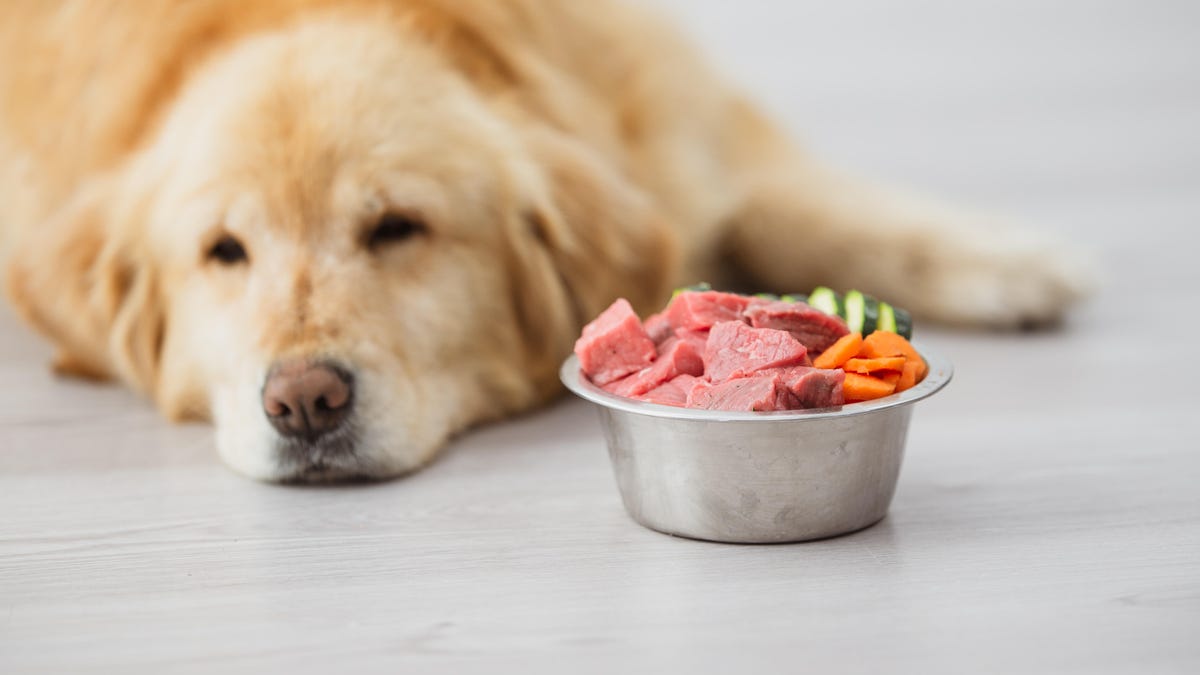Thinking about feeding your dog raw food? Think again
Raw dog food poses a threat to public health by spreading antibiotic-resistant bacteria, researchers say. An expert explains.

Pet owners want the best for their animals, which includes feeding them the best diet possible. In recent years, many pet parents have begun turning to a fresh diet consisting of home-cooked foods -- or, sometimes, food that's completely raw. Some claim a raw food diet leads to shinier coats, healthier teeth and better overall health for dogs.
Raw food is uncooked food, mostly meat, and can be homemade by pet owners or store bought frozen. A recent study from Portugal, however, found that while commercial dog food of all types can harbor some nasty bacteria, raw dog food poses a high risk of transmitting bacteria that are resistant to antibiotics, which can harm immunocompromised pets and people, while also adding to a larger public health problem of antibiotic resistance. Of the 14 commercial types of frozen raw dog food tested in the study, all 14 tested positive for strains of enterococcus that showed drug resistance.
While dogs probably enjoy eating raw meat (we wish we could ask them), many experts advise against it because of the bacteria found in raw food. The American Veterinary Medical Association "discourages" pet owners from feeding animals meat that hasn't been "subjected to a process to eliminate pathogens" such as cooking or pasteurization, citing a risk of food-borne illness that can spread and affect livestock and humans, especially children, the elderly and immunocompromised people.
"This is a true public health concern," Dr. Camille Torres, veterinarian and head of the small animal nutrition service at Colorado State University, says. "It comes up every once in a while as though it's a new topic, but we've known about this for years."
To learn more about the potential risks and benefits to a raw food diet, we talked to Torres about feeding your pets raw food.
Why raw dog food?
The idea of a raw diet for dogs took off after Australian veterinarian Dr. Ian Billinghurst published a book about how dogs would thrive on an evolutionary diet that sustained them before they were domesticated, consisting primarily of raw meat, organs, bones and vegetables.
Torres is empathetic toward pet owners who are considering the raw food diet, because she sees their perspective as a want to do the best for their pet.
"It's somewhat of a sensitive topic, because I think there's a lot of passion around nutrition in general from a pet owner's perspective, and really a strong desire to want to feed the best," Torres says.
What are the risks and benefits?
Supporters of raw food claim that it offers numerous benefits to dogs, including more energy as well as healthier teeth, skin and coats. Torres says there isn't much evidence proving the benefits of feeding pets raw food, but that there is evidence of the health risks, such as pathogenic bacterial exposure.
"It's not that it couldn't have benefits, it's just that those benefits have yet to be proven," Torres says. "Basically, we don't have a lot of evidence to support the pros, and there's evidence to support the risks not just to our pets, but also to the people and their environment."
Does all raw meat have bacteria, and is it all bad?
All uncooked meat has bacteria, Torres says -- "it's just a matter of the type that's there."
"When you take away one of the big ways we cut back on bacterial contamination by cooking, whether that's chicken or beef, it's in the food," Torres says. "So whether it's from the cleanest grocery store, or if it's organic and natural or labeled… the bacterial contamination is there."
Torres also says that we might not be seeing a lot of sick dogs because their immune systems (usually) work well against harmful bacteria, but it's a big problem when they don't.
"That's the flip side -- yes, most dogs and cats might be OK," Torres says. "But if they're not okay, they get really, really sick." Salmonella is an example, Torres says, that can get into the intestinal lining and cause an inflammatory reaction. Immunocompromised dogs, puppies and older dogs are especially at risk, she says.
How can bacteria from raw food spread to humans?
Fecal contamination can transmit harmful bacteria from dogs to humans or other pets in the household, even if you can't see the feces, Torres says.
"It can be on their paws, and they walk inside," Torres says. "They get on our couch, they get on our bed, those types of things. That's the challenge with it -- you can only clean what you know is there."
As far as how serious the bacteria contamination can be, "it's just a matter of what we're exposed to and what our body is capable of fighting off," Torres says. Similar to pets, most people will be okay, she says, but the contamination can lead to serious effects like dehydration and hospitalization.
What about prevention?
If you're dead set on feeding your pet raw food, "be very careful with cleaning the environment, and what the food has come in contact with," Torres says. Wash dishes and, ideally, don't have the raw food in your kitchen (or the place where you prep your own food) at all, she says.
It's also important to practice good hygiene in general, such as washing your hands after playing with your pet, and having children be in the habit of washing their hands and faces if they've been licked. "Those types of things, just to try to stay as healthy as possible," Torres says.

